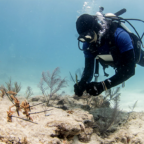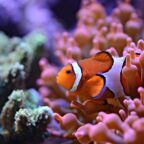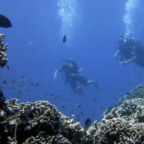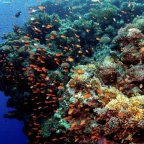
For the history of life on Earth, organisms have relied on the light of the sun, moon, and stars to navigate their way and schedule their lives. While the onset of electric lighting in the late 19th century may have been a boon to humans, it has wreaked havoc on the natural world. Among the more notorious impacts of artificial light at night (ALAN), light pollution lures migrating birds to cities with devastating consequences, contributes to the alarming decline in insect populations, and convinces sea turtle hatchlings to amble away from the water instead of towards it.
Now, a new study from the University of Plymouth adds another dismal finding about how ALAN is affecting the creatures with whom we share the planet: Light pollution from coastal cities can trick coral reefs into spawning outside of the optimum times when they would normally reproduce. And it’s a big deal.
“Coral reefs are among the most biodiverse, economically important, and threatened ecosystems on the planet,” write the authors of the study.
“Climate change induced mass bleaching events, habitat destruction, fisheries, and pollution combined have reduced coral reef cover substantially since the 1950s,” they write, adding: “The complete loss of tropical corals is anticipated over the next 100 years.”
Using a combination of light pollution data and spawning observations, researchers were able to show for the first time that corals exposed to artificial light at night (ALAN) are spawning one to three days closer to the full moon compared to those on unlit reefs. That shift may reduce the survival and fertilization success of gametes and genetic connectivity between nearby lit and unlit reef systems, they explain.
Lead author Dr. Thomas Davies, lecturer in marine conservation at the University of Plymouth, says: “Corals are critical for the health of the global ocean, but are being increasingly damaged by human activity. This study shows it is not just changes in the ocean that are impacting them, but the continued development of coastal cities as we try and accommodate the growing global population.”
It’s a Matter of Timing
Coral “broadcast spawning events” are egg releases on certain nights of the year, triggered by lunar cycles. The timing is critical to the maintenance and recovery of reefs, especially after mass bleaching and other disruptive events.
If corals are spawning on different nights, inspired to do so by the confusion of light pollution, it could reduce the likelihood of coral eggs being fertilized and surviving to produce new adult corals that help reefs to recover after the disturbances they’ve been suffering.
“It is widely accepted that the evolutionary benefit of synchronized mass spawning in corals is maximized reproductive contact between gametes,” notes the study. “Reproductive contact is maximized firstly by the precision of the spawning event, which results in high concentrations of gametes in the water column.”
When the timing is askew, fertilization success and post-fertilization survival are significantly reduced. Among other threats, like increased predation, spawning closer to the full moon means stronger tidal currents that are more likely to carry gametes adrift.
The Solution Should be Simple
The only good thing that can be said about light pollution is this: It’s one of the least complicated pollution sources to fix. Solving plastic pollution and greenhouse gas emissions will take a humanity-wide sea change to fix, but light pollution? We just have to dim the lights.
“If we want to mitigate against the harm this is causing, we could perhaps look to delay the switching on of night-time lighting in coastal regions to ensure the natural dark period between sunset and moonrise that triggers spawning remains in tact,” says Davies.
Co-author Professor Oren Levy, who heads the Laboratory for Molecular Marine Ecology at Bar-Ilan University in Israel, adds, ”It is crucial that we take immediate action to reduce the impact of ALAN on these fragile marine ecosystems. By implementing measures to limit light pollution, we can protect these vital habitats and safeguard the future of the world’s oceans. It’s our responsibility to ensure that we preserve the biodiversity of our planet and maintain a healthy and sustainable environment for generations to come.”
The message is simple and for everyone everywhere, not just in coastal communities: Dim the lights at night. Lights at night devour energy while we’re sleeping and deleteriously throw off the schedule of organisms great and small. For anyone concerned about safety, install a motion sensor.
The coral reefs—and the rest of the natural world—thank you in advance.
The study, “Global disruption of coral broadcast spawning associated with artificial light at night,” was published in Nature Communications.















Social Profiles